BUS707 Applied Research: Intellectual Capital & Financial Impact
VerifiedAdded on 2023/06/12
|29
|6420
|310
Report
AI Summary
This research proposal investigates the impact of intellectual capital on the financial performance of banks in Australia, addressing a research problem centered on the lack of proper intellectual capital management and its potential to deteriorate financial outcomes. The proposal outlines objectives to identify the relationship between intellectual capital and financial performance, evaluate its impact, assess its value addition to Australian banks, and provide recommendations for improved management. A literature review explores the link between intellectual capital, knowledge, and their impact on banks, while the research methodology details the designs, approaches, and strategies for data collection and analysis. The study considers ethical considerations, reliability, and validity, culminating in an action plan for achieving the research objectives.
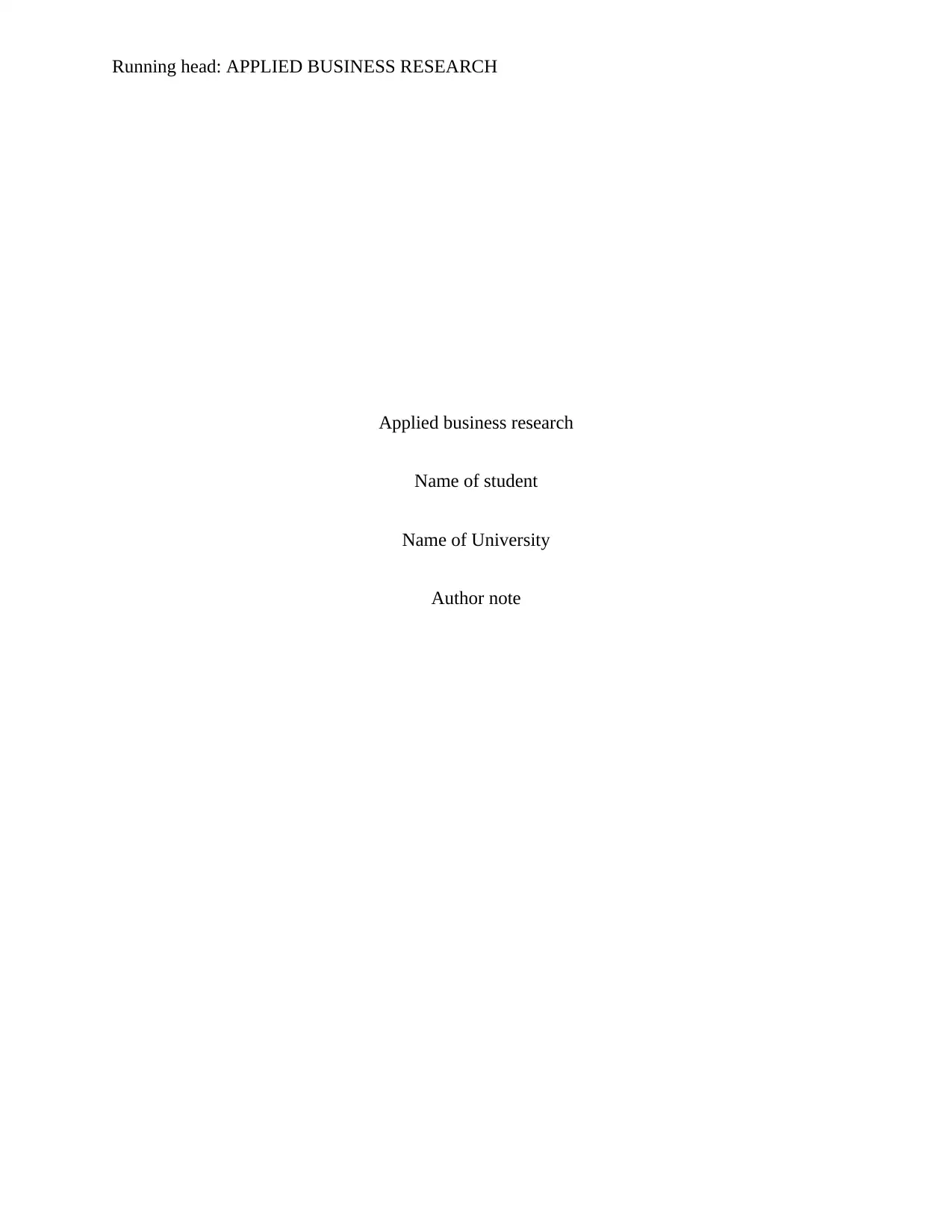
Running head: APPLIED BUSINESS RESEARCH
Applied business research
Name of student
Name of University
Author note
Applied business research
Name of student
Name of University
Author note
Paraphrase This Document
Need a fresh take? Get an instant paraphrase of this document with our AI Paraphraser
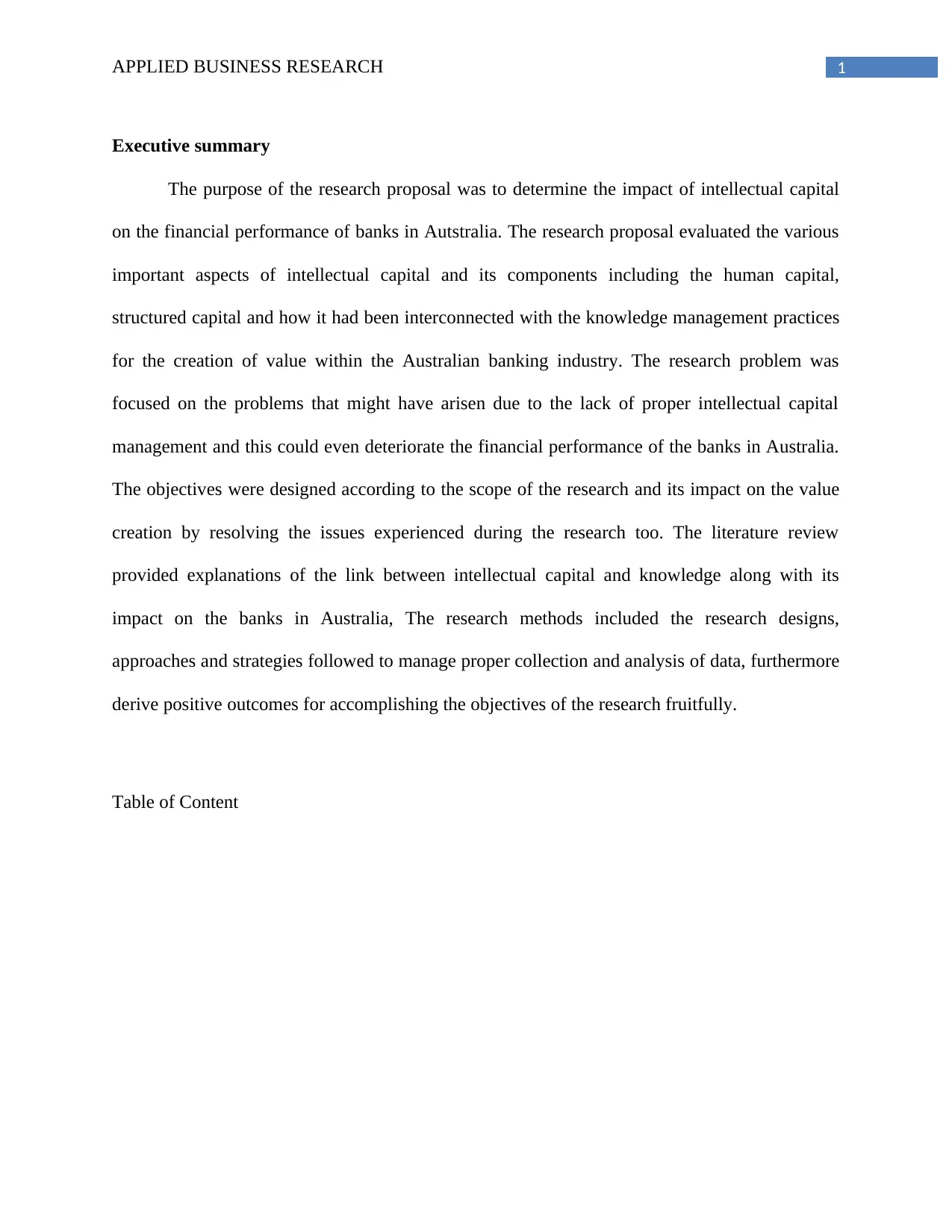
1APPLIED BUSINESS RESEARCH
Executive summary
The purpose of the research proposal was to determine the impact of intellectual capital
on the financial performance of banks in Autstralia. The research proposal evaluated the various
important aspects of intellectual capital and its components including the human capital,
structured capital and how it had been interconnected with the knowledge management practices
for the creation of value within the Australian banking industry. The research problem was
focused on the problems that might have arisen due to the lack of proper intellectual capital
management and this could even deteriorate the financial performance of the banks in Australia.
The objectives were designed according to the scope of the research and its impact on the value
creation by resolving the issues experienced during the research too. The literature review
provided explanations of the link between intellectual capital and knowledge along with its
impact on the banks in Australia, The research methods included the research designs,
approaches and strategies followed to manage proper collection and analysis of data, furthermore
derive positive outcomes for accomplishing the objectives of the research fruitfully.
Table of Content
Executive summary
The purpose of the research proposal was to determine the impact of intellectual capital
on the financial performance of banks in Autstralia. The research proposal evaluated the various
important aspects of intellectual capital and its components including the human capital,
structured capital and how it had been interconnected with the knowledge management practices
for the creation of value within the Australian banking industry. The research problem was
focused on the problems that might have arisen due to the lack of proper intellectual capital
management and this could even deteriorate the financial performance of the banks in Australia.
The objectives were designed according to the scope of the research and its impact on the value
creation by resolving the issues experienced during the research too. The literature review
provided explanations of the link between intellectual capital and knowledge along with its
impact on the banks in Australia, The research methods included the research designs,
approaches and strategies followed to manage proper collection and analysis of data, furthermore
derive positive outcomes for accomplishing the objectives of the research fruitfully.
Table of Content
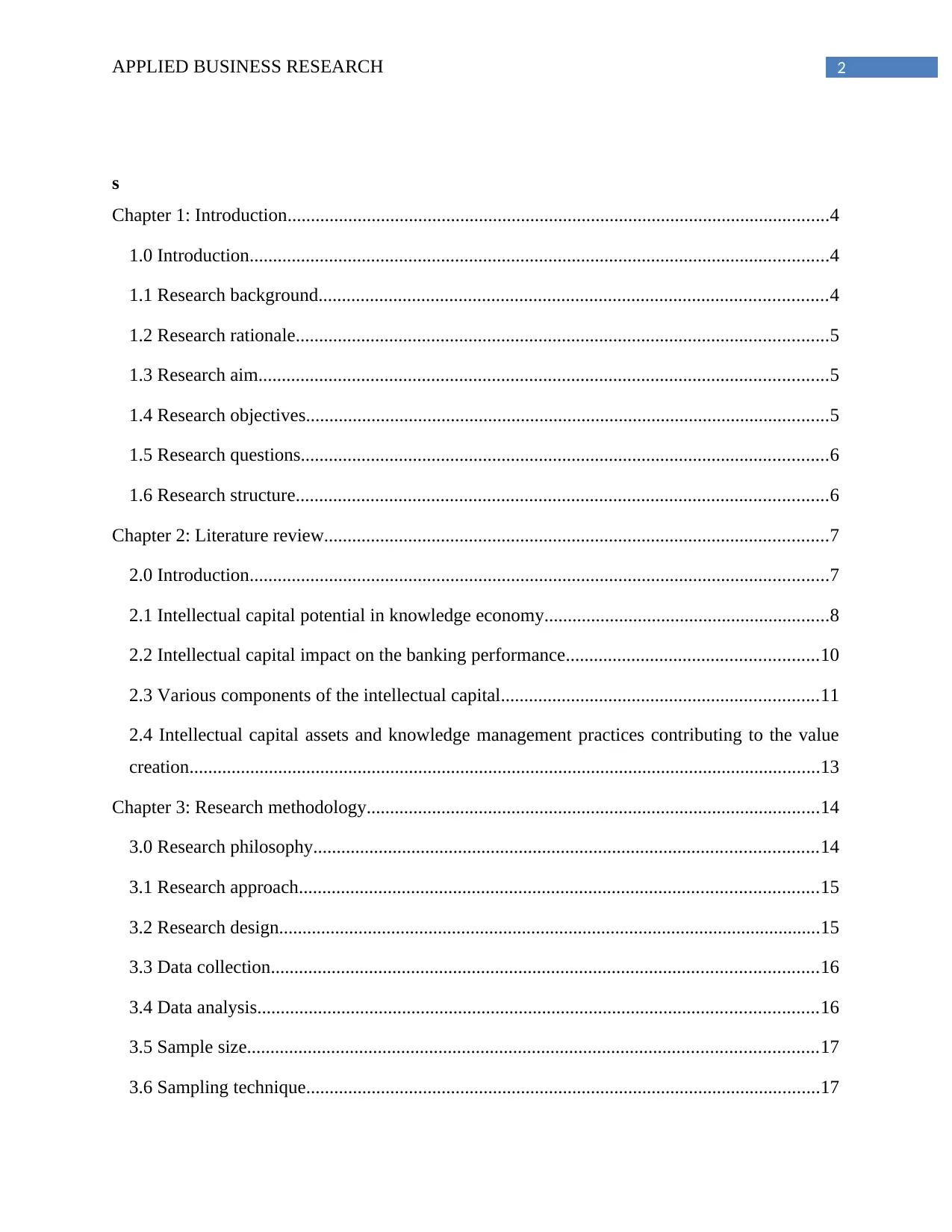
2APPLIED BUSINESS RESEARCH
s
Chapter 1: Introduction....................................................................................................................4
1.0 Introduction............................................................................................................................4
1.1 Research background.............................................................................................................4
1.2 Research rationale..................................................................................................................5
1.3 Research aim..........................................................................................................................5
1.4 Research objectives................................................................................................................5
1.5 Research questions.................................................................................................................6
1.6 Research structure..................................................................................................................6
Chapter 2: Literature review............................................................................................................7
2.0 Introduction............................................................................................................................7
2.1 Intellectual capital potential in knowledge economy.............................................................8
2.2 Intellectual capital impact on the banking performance......................................................10
2.3 Various components of the intellectual capital....................................................................11
2.4 Intellectual capital assets and knowledge management practices contributing to the value
creation.......................................................................................................................................13
Chapter 3: Research methodology.................................................................................................14
3.0 Research philosophy............................................................................................................14
3.1 Research approach...............................................................................................................15
3.2 Research design....................................................................................................................15
3.3 Data collection.....................................................................................................................16
3.4 Data analysis........................................................................................................................16
3.5 Sample size..........................................................................................................................17
3.6 Sampling technique..............................................................................................................17
s
Chapter 1: Introduction....................................................................................................................4
1.0 Introduction............................................................................................................................4
1.1 Research background.............................................................................................................4
1.2 Research rationale..................................................................................................................5
1.3 Research aim..........................................................................................................................5
1.4 Research objectives................................................................................................................5
1.5 Research questions.................................................................................................................6
1.6 Research structure..................................................................................................................6
Chapter 2: Literature review............................................................................................................7
2.0 Introduction............................................................................................................................7
2.1 Intellectual capital potential in knowledge economy.............................................................8
2.2 Intellectual capital impact on the banking performance......................................................10
2.3 Various components of the intellectual capital....................................................................11
2.4 Intellectual capital assets and knowledge management practices contributing to the value
creation.......................................................................................................................................13
Chapter 3: Research methodology.................................................................................................14
3.0 Research philosophy............................................................................................................14
3.1 Research approach...............................................................................................................15
3.2 Research design....................................................................................................................15
3.3 Data collection.....................................................................................................................16
3.4 Data analysis........................................................................................................................16
3.5 Sample size..........................................................................................................................17
3.6 Sampling technique..............................................................................................................17
⊘ This is a preview!⊘
Do you want full access?
Subscribe today to unlock all pages.

Trusted by 1+ million students worldwide

3APPLIED BUSINESS RESEARCH
3.7 Ethical consideration............................................................................................................17
3.8 Reliability and validity.........................................................................................................18
4.0 Action plan...............................................................................................................................18
References......................................................................................................................................21
3.7 Ethical consideration............................................................................................................17
3.8 Reliability and validity.........................................................................................................18
4.0 Action plan...............................................................................................................................18
References......................................................................................................................................21
Paraphrase This Document
Need a fresh take? Get an instant paraphrase of this document with our AI Paraphraser
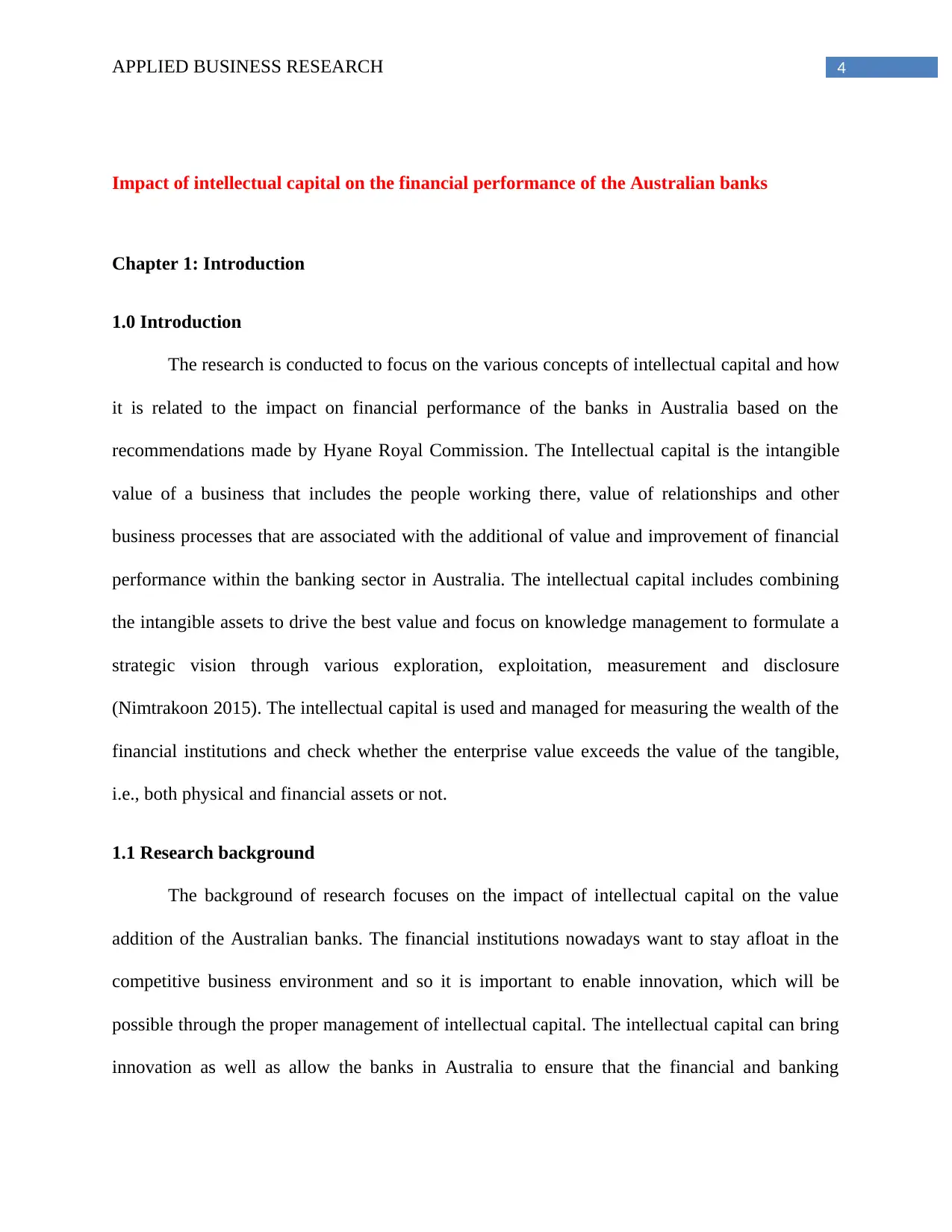
4APPLIED BUSINESS RESEARCH
Impact of intellectual capital on the financial performance of the Australian banks
Chapter 1: Introduction
1.0 Introduction
The research is conducted to focus on the various concepts of intellectual capital and how
it is related to the impact on financial performance of the banks in Australia based on the
recommendations made by Hyane Royal Commission. The Intellectual capital is the intangible
value of a business that includes the people working there, value of relationships and other
business processes that are associated with the additional of value and improvement of financial
performance within the banking sector in Australia. The intellectual capital includes combining
the intangible assets to drive the best value and focus on knowledge management to formulate a
strategic vision through various exploration, exploitation, measurement and disclosure
(Nimtrakoon 2015). The intellectual capital is used and managed for measuring the wealth of the
financial institutions and check whether the enterprise value exceeds the value of the tangible,
i.e., both physical and financial assets or not.
1.1 Research background
The background of research focuses on the impact of intellectual capital on the value
addition of the Australian banks. The financial institutions nowadays want to stay afloat in the
competitive business environment and so it is important to enable innovation, which will be
possible through the proper management of intellectual capital. The intellectual capital can bring
innovation as well as allow the banks in Australia to ensure that the financial and banking
Impact of intellectual capital on the financial performance of the Australian banks
Chapter 1: Introduction
1.0 Introduction
The research is conducted to focus on the various concepts of intellectual capital and how
it is related to the impact on financial performance of the banks in Australia based on the
recommendations made by Hyane Royal Commission. The Intellectual capital is the intangible
value of a business that includes the people working there, value of relationships and other
business processes that are associated with the additional of value and improvement of financial
performance within the banking sector in Australia. The intellectual capital includes combining
the intangible assets to drive the best value and focus on knowledge management to formulate a
strategic vision through various exploration, exploitation, measurement and disclosure
(Nimtrakoon 2015). The intellectual capital is used and managed for measuring the wealth of the
financial institutions and check whether the enterprise value exceeds the value of the tangible,
i.e., both physical and financial assets or not.
1.1 Research background
The background of research focuses on the impact of intellectual capital on the value
addition of the Australian banks. The financial institutions nowadays want to stay afloat in the
competitive business environment and so it is important to enable innovation, which will be
possible through the proper management of intellectual capital. The intellectual capital can bring
innovation as well as allow the banks in Australia to ensure that the financial and banking
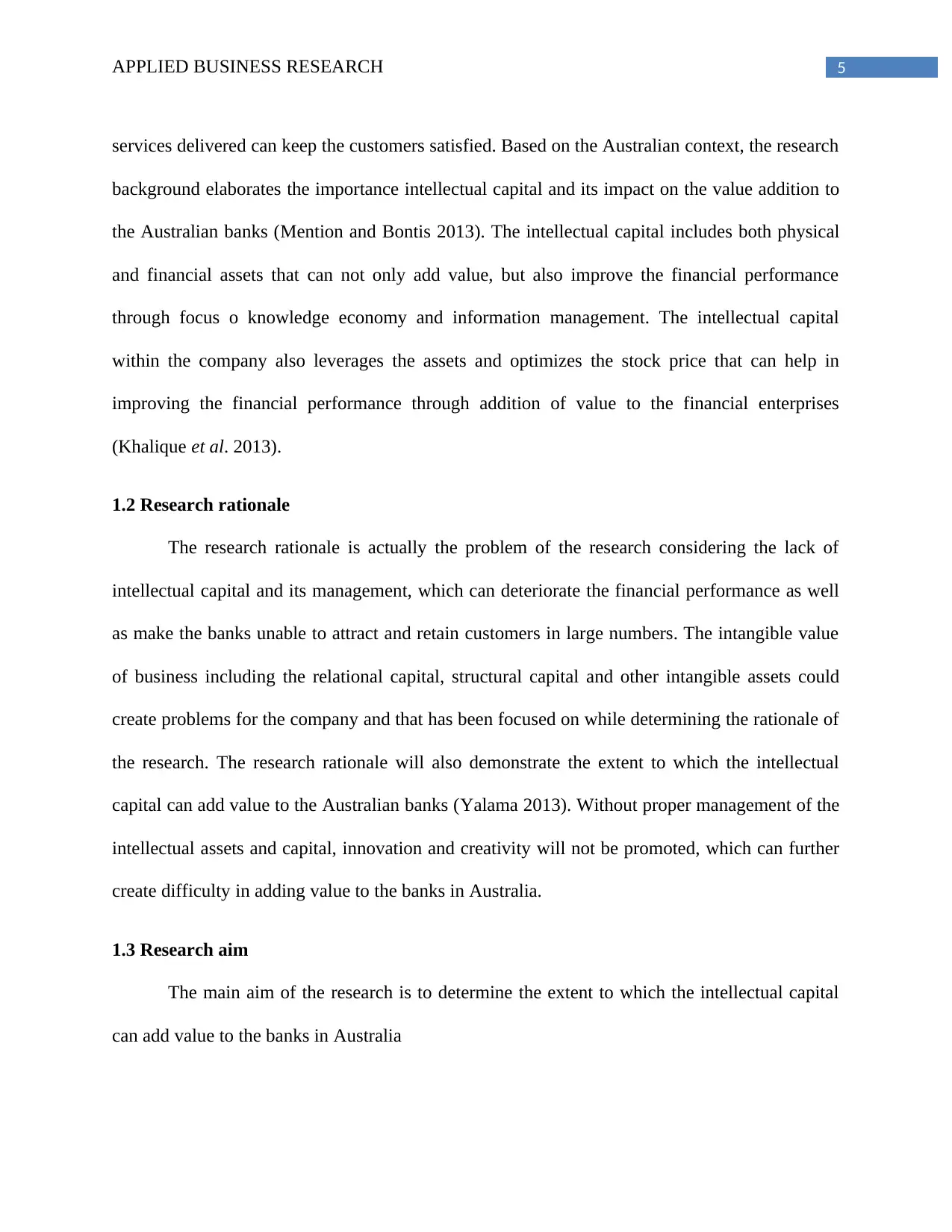
5APPLIED BUSINESS RESEARCH
services delivered can keep the customers satisfied. Based on the Australian context, the research
background elaborates the importance intellectual capital and its impact on the value addition to
the Australian banks (Mention and Bontis 2013). The intellectual capital includes both physical
and financial assets that can not only add value, but also improve the financial performance
through focus o knowledge economy and information management. The intellectual capital
within the company also leverages the assets and optimizes the stock price that can help in
improving the financial performance through addition of value to the financial enterprises
(Khalique et al. 2013).
1.2 Research rationale
The research rationale is actually the problem of the research considering the lack of
intellectual capital and its management, which can deteriorate the financial performance as well
as make the banks unable to attract and retain customers in large numbers. The intangible value
of business including the relational capital, structural capital and other intangible assets could
create problems for the company and that has been focused on while determining the rationale of
the research. The research rationale will also demonstrate the extent to which the intellectual
capital can add value to the Australian banks (Yalama 2013). Without proper management of the
intellectual assets and capital, innovation and creativity will not be promoted, which can further
create difficulty in adding value to the banks in Australia.
1.3 Research aim
The main aim of the research is to determine the extent to which the intellectual capital
can add value to the banks in Australia
services delivered can keep the customers satisfied. Based on the Australian context, the research
background elaborates the importance intellectual capital and its impact on the value addition to
the Australian banks (Mention and Bontis 2013). The intellectual capital includes both physical
and financial assets that can not only add value, but also improve the financial performance
through focus o knowledge economy and information management. The intellectual capital
within the company also leverages the assets and optimizes the stock price that can help in
improving the financial performance through addition of value to the financial enterprises
(Khalique et al. 2013).
1.2 Research rationale
The research rationale is actually the problem of the research considering the lack of
intellectual capital and its management, which can deteriorate the financial performance as well
as make the banks unable to attract and retain customers in large numbers. The intangible value
of business including the relational capital, structural capital and other intangible assets could
create problems for the company and that has been focused on while determining the rationale of
the research. The research rationale will also demonstrate the extent to which the intellectual
capital can add value to the Australian banks (Yalama 2013). Without proper management of the
intellectual assets and capital, innovation and creativity will not be promoted, which can further
create difficulty in adding value to the banks in Australia.
1.3 Research aim
The main aim of the research is to determine the extent to which the intellectual capital
can add value to the banks in Australia
⊘ This is a preview!⊘
Do you want full access?
Subscribe today to unlock all pages.

Trusted by 1+ million students worldwide
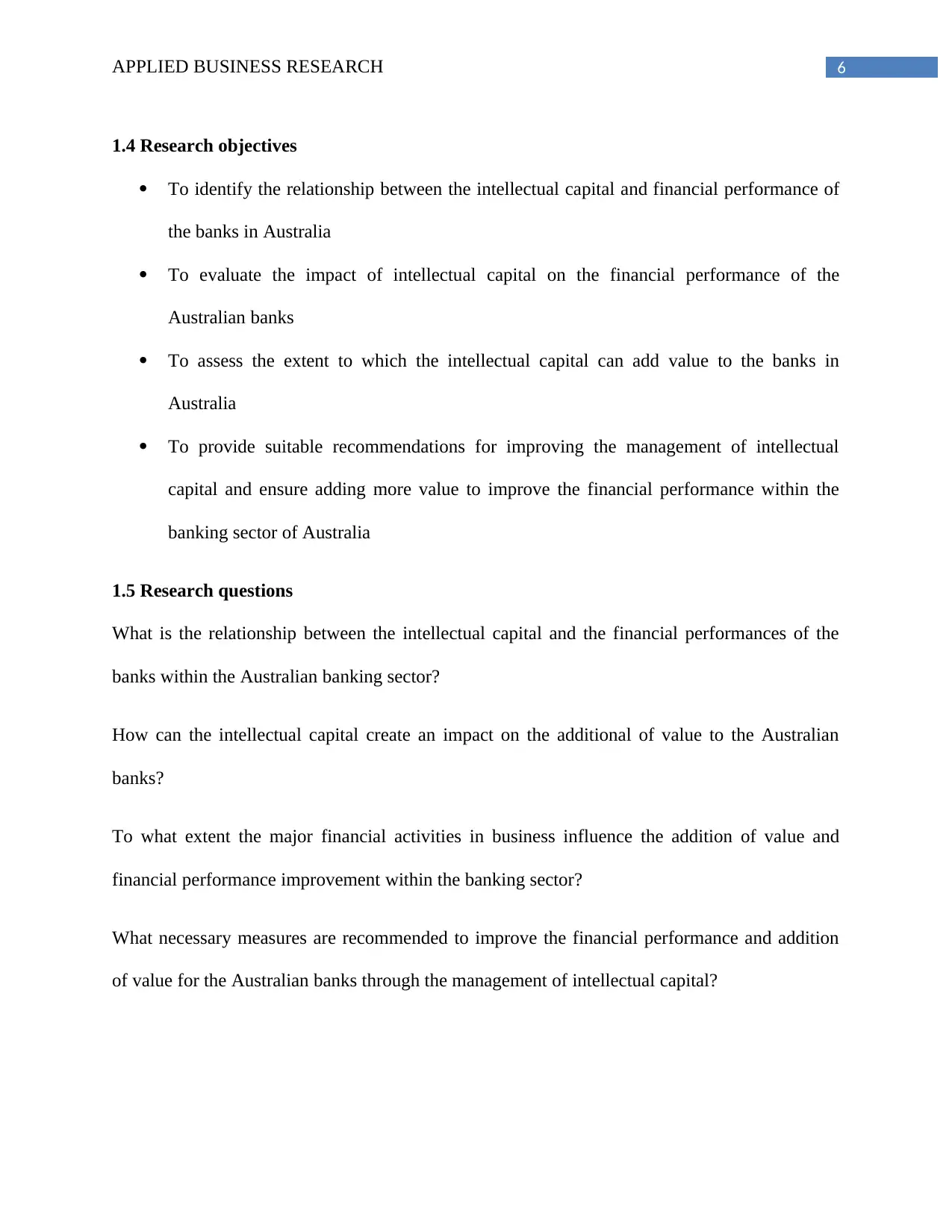
6APPLIED BUSINESS RESEARCH
1.4 Research objectives
To identify the relationship between the intellectual capital and financial performance of
the banks in Australia
To evaluate the impact of intellectual capital on the financial performance of the
Australian banks
To assess the extent to which the intellectual capital can add value to the banks in
Australia
To provide suitable recommendations for improving the management of intellectual
capital and ensure adding more value to improve the financial performance within the
banking sector of Australia
1.5 Research questions
What is the relationship between the intellectual capital and the financial performances of the
banks within the Australian banking sector?
How can the intellectual capital create an impact on the additional of value to the Australian
banks?
To what extent the major financial activities in business influence the addition of value and
financial performance improvement within the banking sector?
What necessary measures are recommended to improve the financial performance and addition
of value for the Australian banks through the management of intellectual capital?
1.4 Research objectives
To identify the relationship between the intellectual capital and financial performance of
the banks in Australia
To evaluate the impact of intellectual capital on the financial performance of the
Australian banks
To assess the extent to which the intellectual capital can add value to the banks in
Australia
To provide suitable recommendations for improving the management of intellectual
capital and ensure adding more value to improve the financial performance within the
banking sector of Australia
1.5 Research questions
What is the relationship between the intellectual capital and the financial performances of the
banks within the Australian banking sector?
How can the intellectual capital create an impact on the additional of value to the Australian
banks?
To what extent the major financial activities in business influence the addition of value and
financial performance improvement within the banking sector?
What necessary measures are recommended to improve the financial performance and addition
of value for the Australian banks through the management of intellectual capital?
Paraphrase This Document
Need a fresh take? Get an instant paraphrase of this document with our AI Paraphraser
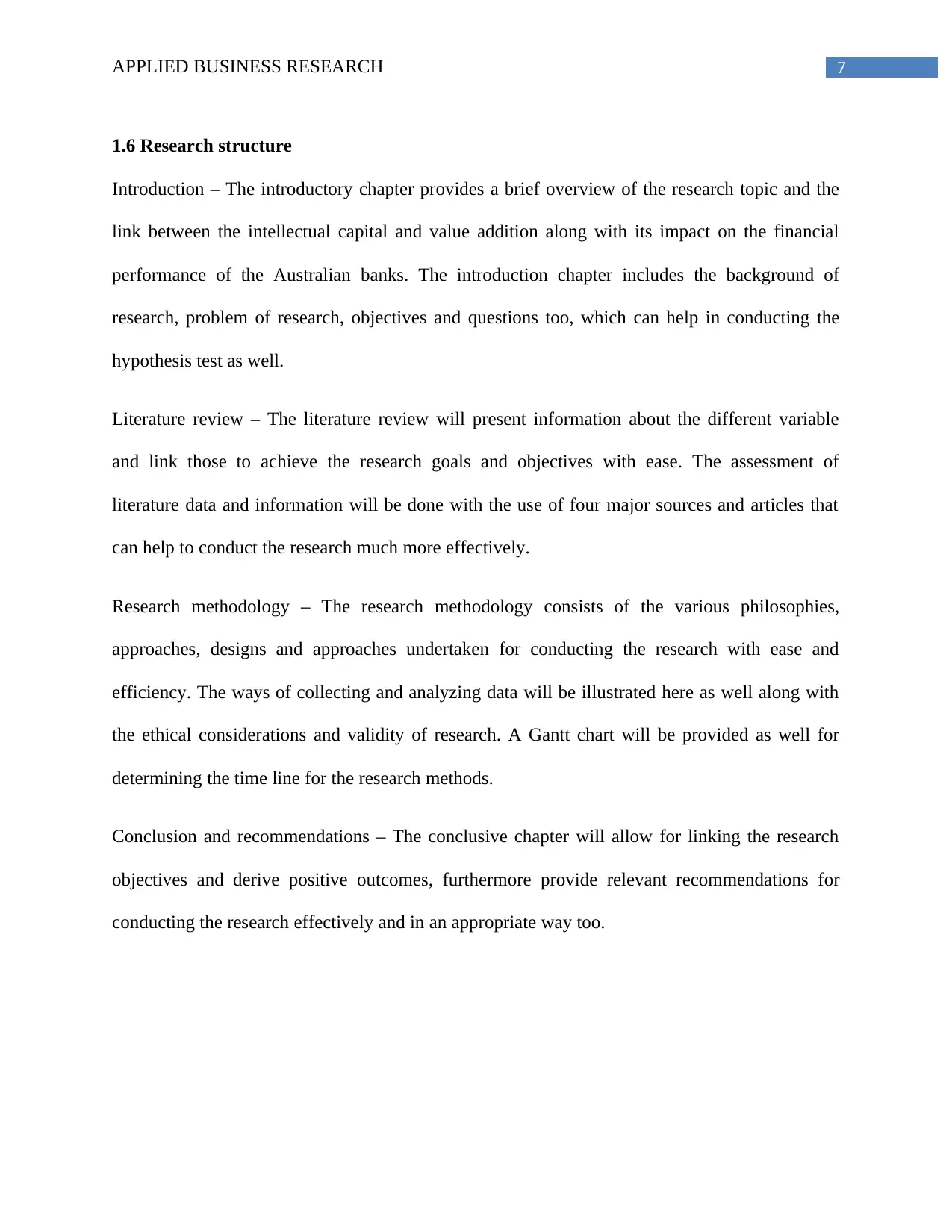
7APPLIED BUSINESS RESEARCH
1.6 Research structure
Introduction – The introductory chapter provides a brief overview of the research topic and the
link between the intellectual capital and value addition along with its impact on the financial
performance of the Australian banks. The introduction chapter includes the background of
research, problem of research, objectives and questions too, which can help in conducting the
hypothesis test as well.
Literature review – The literature review will present information about the different variable
and link those to achieve the research goals and objectives with ease. The assessment of
literature data and information will be done with the use of four major sources and articles that
can help to conduct the research much more effectively.
Research methodology – The research methodology consists of the various philosophies,
approaches, designs and approaches undertaken for conducting the research with ease and
efficiency. The ways of collecting and analyzing data will be illustrated here as well along with
the ethical considerations and validity of research. A Gantt chart will be provided as well for
determining the time line for the research methods.
Conclusion and recommendations – The conclusive chapter will allow for linking the research
objectives and derive positive outcomes, furthermore provide relevant recommendations for
conducting the research effectively and in an appropriate way too.
1.6 Research structure
Introduction – The introductory chapter provides a brief overview of the research topic and the
link between the intellectual capital and value addition along with its impact on the financial
performance of the Australian banks. The introduction chapter includes the background of
research, problem of research, objectives and questions too, which can help in conducting the
hypothesis test as well.
Literature review – The literature review will present information about the different variable
and link those to achieve the research goals and objectives with ease. The assessment of
literature data and information will be done with the use of four major sources and articles that
can help to conduct the research much more effectively.
Research methodology – The research methodology consists of the various philosophies,
approaches, designs and approaches undertaken for conducting the research with ease and
efficiency. The ways of collecting and analyzing data will be illustrated here as well along with
the ethical considerations and validity of research. A Gantt chart will be provided as well for
determining the time line for the research methods.
Conclusion and recommendations – The conclusive chapter will allow for linking the research
objectives and derive positive outcomes, furthermore provide relevant recommendations for
conducting the research effectively and in an appropriate way too.
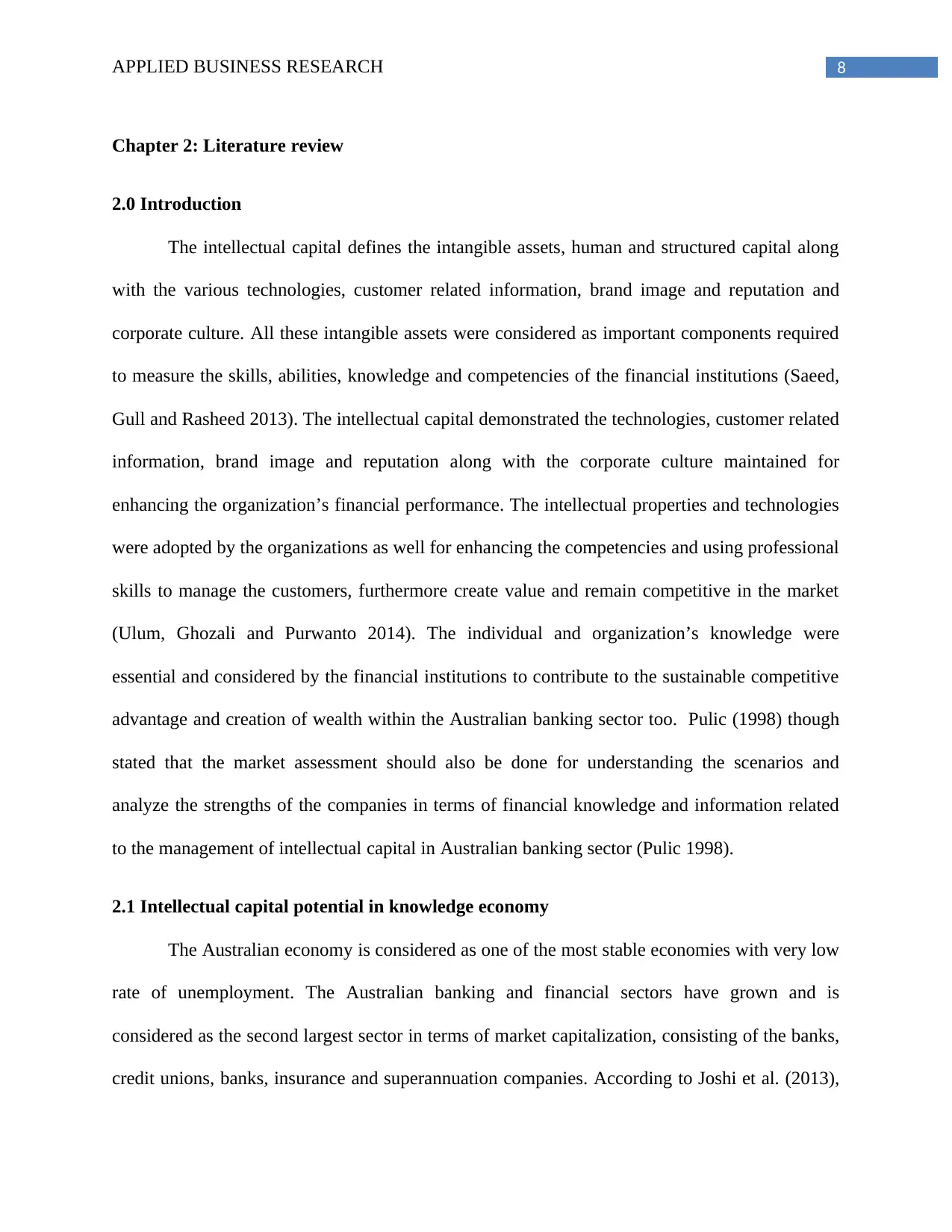
8APPLIED BUSINESS RESEARCH
Chapter 2: Literature review
2.0 Introduction
The intellectual capital defines the intangible assets, human and structured capital along
with the various technologies, customer related information, brand image and reputation and
corporate culture. All these intangible assets were considered as important components required
to measure the skills, abilities, knowledge and competencies of the financial institutions (Saeed,
Gull and Rasheed 2013). The intellectual capital demonstrated the technologies, customer related
information, brand image and reputation along with the corporate culture maintained for
enhancing the organization’s financial performance. The intellectual properties and technologies
were adopted by the organizations as well for enhancing the competencies and using professional
skills to manage the customers, furthermore create value and remain competitive in the market
(Ulum, Ghozali and Purwanto 2014). The individual and organization’s knowledge were
essential and considered by the financial institutions to contribute to the sustainable competitive
advantage and creation of wealth within the Australian banking sector too. Pulic (1998) though
stated that the market assessment should also be done for understanding the scenarios and
analyze the strengths of the companies in terms of financial knowledge and information related
to the management of intellectual capital in Australian banking sector (Pulic 1998).
2.1 Intellectual capital potential in knowledge economy
The Australian economy is considered as one of the most stable economies with very low
rate of unemployment. The Australian banking and financial sectors have grown and is
considered as the second largest sector in terms of market capitalization, consisting of the banks,
credit unions, banks, insurance and superannuation companies. According to Joshi et al. (2013),
Chapter 2: Literature review
2.0 Introduction
The intellectual capital defines the intangible assets, human and structured capital along
with the various technologies, customer related information, brand image and reputation and
corporate culture. All these intangible assets were considered as important components required
to measure the skills, abilities, knowledge and competencies of the financial institutions (Saeed,
Gull and Rasheed 2013). The intellectual capital demonstrated the technologies, customer related
information, brand image and reputation along with the corporate culture maintained for
enhancing the organization’s financial performance. The intellectual properties and technologies
were adopted by the organizations as well for enhancing the competencies and using professional
skills to manage the customers, furthermore create value and remain competitive in the market
(Ulum, Ghozali and Purwanto 2014). The individual and organization’s knowledge were
essential and considered by the financial institutions to contribute to the sustainable competitive
advantage and creation of wealth within the Australian banking sector too. Pulic (1998) though
stated that the market assessment should also be done for understanding the scenarios and
analyze the strengths of the companies in terms of financial knowledge and information related
to the management of intellectual capital in Australian banking sector (Pulic 1998).
2.1 Intellectual capital potential in knowledge economy
The Australian economy is considered as one of the most stable economies with very low
rate of unemployment. The Australian banking and financial sectors have grown and is
considered as the second largest sector in terms of market capitalization, consisting of the banks,
credit unions, banks, insurance and superannuation companies. According to Joshi et al. (2013),
⊘ This is a preview!⊘
Do you want full access?
Subscribe today to unlock all pages.

Trusted by 1+ million students worldwide
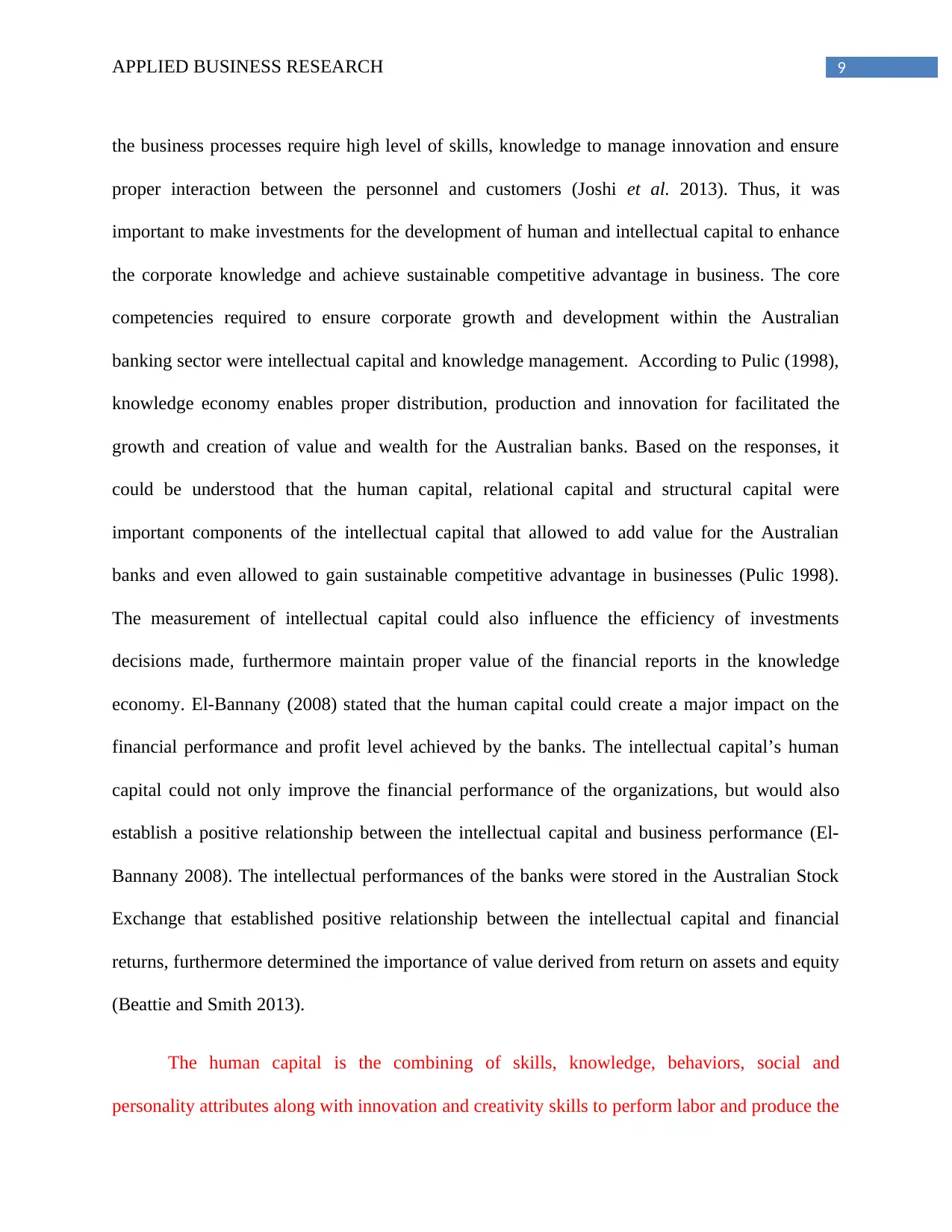
9APPLIED BUSINESS RESEARCH
the business processes require high level of skills, knowledge to manage innovation and ensure
proper interaction between the personnel and customers (Joshi et al. 2013). Thus, it was
important to make investments for the development of human and intellectual capital to enhance
the corporate knowledge and achieve sustainable competitive advantage in business. The core
competencies required to ensure corporate growth and development within the Australian
banking sector were intellectual capital and knowledge management. According to Pulic (1998),
knowledge economy enables proper distribution, production and innovation for facilitated the
growth and creation of value and wealth for the Australian banks. Based on the responses, it
could be understood that the human capital, relational capital and structural capital were
important components of the intellectual capital that allowed to add value for the Australian
banks and even allowed to gain sustainable competitive advantage in businesses (Pulic 1998).
The measurement of intellectual capital could also influence the efficiency of investments
decisions made, furthermore maintain proper value of the financial reports in the knowledge
economy. El-Bannany (2008) stated that the human capital could create a major impact on the
financial performance and profit level achieved by the banks. The intellectual capital’s human
capital could not only improve the financial performance of the organizations, but would also
establish a positive relationship between the intellectual capital and business performance (El-
Bannany 2008). The intellectual performances of the banks were stored in the Australian Stock
Exchange that established positive relationship between the intellectual capital and financial
returns, furthermore determined the importance of value derived from return on assets and equity
(Beattie and Smith 2013).
The human capital is the combining of skills, knowledge, behaviors, social and
personality attributes along with innovation and creativity skills to perform labor and produce the
the business processes require high level of skills, knowledge to manage innovation and ensure
proper interaction between the personnel and customers (Joshi et al. 2013). Thus, it was
important to make investments for the development of human and intellectual capital to enhance
the corporate knowledge and achieve sustainable competitive advantage in business. The core
competencies required to ensure corporate growth and development within the Australian
banking sector were intellectual capital and knowledge management. According to Pulic (1998),
knowledge economy enables proper distribution, production and innovation for facilitated the
growth and creation of value and wealth for the Australian banks. Based on the responses, it
could be understood that the human capital, relational capital and structural capital were
important components of the intellectual capital that allowed to add value for the Australian
banks and even allowed to gain sustainable competitive advantage in businesses (Pulic 1998).
The measurement of intellectual capital could also influence the efficiency of investments
decisions made, furthermore maintain proper value of the financial reports in the knowledge
economy. El-Bannany (2008) stated that the human capital could create a major impact on the
financial performance and profit level achieved by the banks. The intellectual capital’s human
capital could not only improve the financial performance of the organizations, but would also
establish a positive relationship between the intellectual capital and business performance (El-
Bannany 2008). The intellectual performances of the banks were stored in the Australian Stock
Exchange that established positive relationship between the intellectual capital and financial
returns, furthermore determined the importance of value derived from return on assets and equity
(Beattie and Smith 2013).
The human capital is the combining of skills, knowledge, behaviors, social and
personality attributes along with innovation and creativity skills to perform labor and produce the
Paraphrase This Document
Need a fresh take? Get an instant paraphrase of this document with our AI Paraphraser
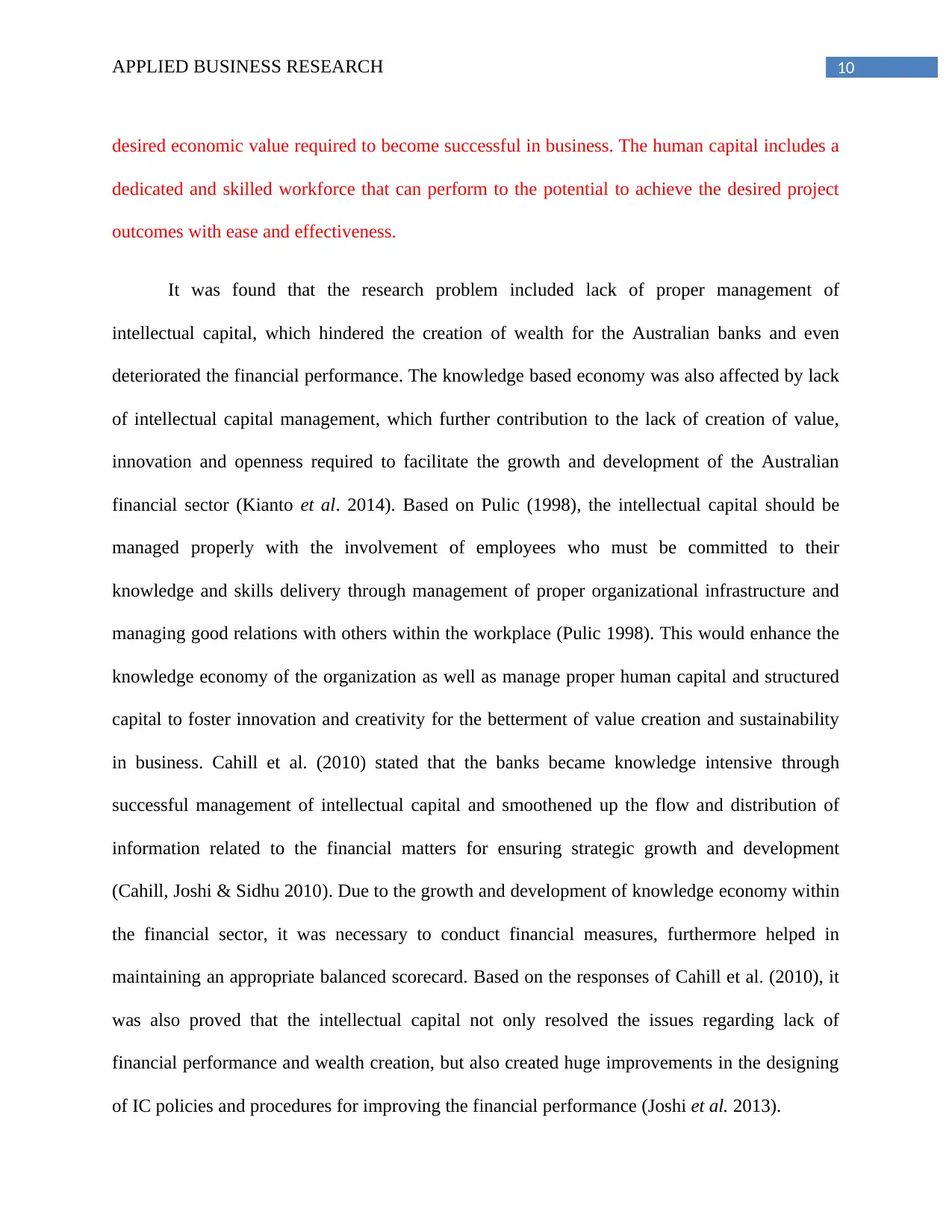
10APPLIED BUSINESS RESEARCH
desired economic value required to become successful in business. The human capital includes a
dedicated and skilled workforce that can perform to the potential to achieve the desired project
outcomes with ease and effectiveness.
It was found that the research problem included lack of proper management of
intellectual capital, which hindered the creation of wealth for the Australian banks and even
deteriorated the financial performance. The knowledge based economy was also affected by lack
of intellectual capital management, which further contribution to the lack of creation of value,
innovation and openness required to facilitate the growth and development of the Australian
financial sector (Kianto et al. 2014). Based on Pulic (1998), the intellectual capital should be
managed properly with the involvement of employees who must be committed to their
knowledge and skills delivery through management of proper organizational infrastructure and
managing good relations with others within the workplace (Pulic 1998). This would enhance the
knowledge economy of the organization as well as manage proper human capital and structured
capital to foster innovation and creativity for the betterment of value creation and sustainability
in business. Cahill et al. (2010) stated that the banks became knowledge intensive through
successful management of intellectual capital and smoothened up the flow and distribution of
information related to the financial matters for ensuring strategic growth and development
(Cahill, Joshi & Sidhu 2010). Due to the growth and development of knowledge economy within
the financial sector, it was necessary to conduct financial measures, furthermore helped in
maintaining an appropriate balanced scorecard. Based on the responses of Cahill et al. (2010), it
was also proved that the intellectual capital not only resolved the issues regarding lack of
financial performance and wealth creation, but also created huge improvements in the designing
of IC policies and procedures for improving the financial performance (Joshi et al. 2013).
desired economic value required to become successful in business. The human capital includes a
dedicated and skilled workforce that can perform to the potential to achieve the desired project
outcomes with ease and effectiveness.
It was found that the research problem included lack of proper management of
intellectual capital, which hindered the creation of wealth for the Australian banks and even
deteriorated the financial performance. The knowledge based economy was also affected by lack
of intellectual capital management, which further contribution to the lack of creation of value,
innovation and openness required to facilitate the growth and development of the Australian
financial sector (Kianto et al. 2014). Based on Pulic (1998), the intellectual capital should be
managed properly with the involvement of employees who must be committed to their
knowledge and skills delivery through management of proper organizational infrastructure and
managing good relations with others within the workplace (Pulic 1998). This would enhance the
knowledge economy of the organization as well as manage proper human capital and structured
capital to foster innovation and creativity for the betterment of value creation and sustainability
in business. Cahill et al. (2010) stated that the banks became knowledge intensive through
successful management of intellectual capital and smoothened up the flow and distribution of
information related to the financial matters for ensuring strategic growth and development
(Cahill, Joshi & Sidhu 2010). Due to the growth and development of knowledge economy within
the financial sector, it was necessary to conduct financial measures, furthermore helped in
maintaining an appropriate balanced scorecard. Based on the responses of Cahill et al. (2010), it
was also proved that the intellectual capital not only resolved the issues regarding lack of
financial performance and wealth creation, but also created huge improvements in the designing
of IC policies and procedures for improving the financial performance (Joshi et al. 2013).
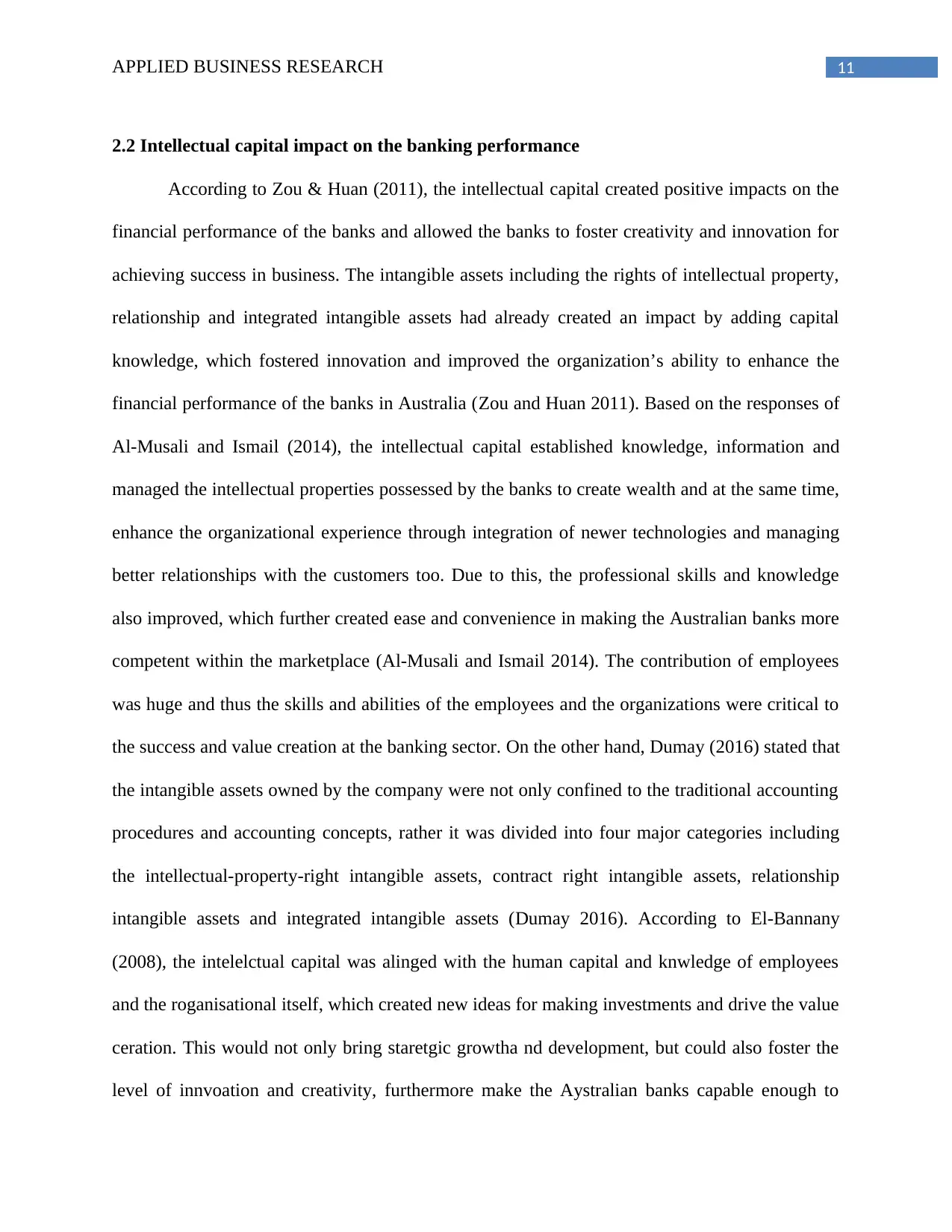
11APPLIED BUSINESS RESEARCH
2.2 Intellectual capital impact on the banking performance
According to Zou & Huan (2011), the intellectual capital created positive impacts on the
financial performance of the banks and allowed the banks to foster creativity and innovation for
achieving success in business. The intangible assets including the rights of intellectual property,
relationship and integrated intangible assets had already created an impact by adding capital
knowledge, which fostered innovation and improved the organization’s ability to enhance the
financial performance of the banks in Australia (Zou and Huan 2011). Based on the responses of
Al-Musali and Ismail (2014), the intellectual capital established knowledge, information and
managed the intellectual properties possessed by the banks to create wealth and at the same time,
enhance the organizational experience through integration of newer technologies and managing
better relationships with the customers too. Due to this, the professional skills and knowledge
also improved, which further created ease and convenience in making the Australian banks more
competent within the marketplace (Al-Musali and Ismail 2014). The contribution of employees
was huge and thus the skills and abilities of the employees and the organizations were critical to
the success and value creation at the banking sector. On the other hand, Dumay (2016) stated that
the intangible assets owned by the company were not only confined to the traditional accounting
procedures and accounting concepts, rather it was divided into four major categories including
the intellectual-property-right intangible assets, contract right intangible assets, relationship
intangible assets and integrated intangible assets (Dumay 2016). According to El-Bannany
(2008), the intelelctual capital was alinged with the human capital and knwledge of employees
and the roganisational itself, which created new ideas for making investments and drive the value
ceration. This would not only bring staretgic growtha nd development, but could also foster the
level of innvoation and creativity, furthermore make the Aystralian banks capable enough to
2.2 Intellectual capital impact on the banking performance
According to Zou & Huan (2011), the intellectual capital created positive impacts on the
financial performance of the banks and allowed the banks to foster creativity and innovation for
achieving success in business. The intangible assets including the rights of intellectual property,
relationship and integrated intangible assets had already created an impact by adding capital
knowledge, which fostered innovation and improved the organization’s ability to enhance the
financial performance of the banks in Australia (Zou and Huan 2011). Based on the responses of
Al-Musali and Ismail (2014), the intellectual capital established knowledge, information and
managed the intellectual properties possessed by the banks to create wealth and at the same time,
enhance the organizational experience through integration of newer technologies and managing
better relationships with the customers too. Due to this, the professional skills and knowledge
also improved, which further created ease and convenience in making the Australian banks more
competent within the marketplace (Al-Musali and Ismail 2014). The contribution of employees
was huge and thus the skills and abilities of the employees and the organizations were critical to
the success and value creation at the banking sector. On the other hand, Dumay (2016) stated that
the intangible assets owned by the company were not only confined to the traditional accounting
procedures and accounting concepts, rather it was divided into four major categories including
the intellectual-property-right intangible assets, contract right intangible assets, relationship
intangible assets and integrated intangible assets (Dumay 2016). According to El-Bannany
(2008), the intelelctual capital was alinged with the human capital and knwledge of employees
and the roganisational itself, which created new ideas for making investments and drive the value
ceration. This would not only bring staretgic growtha nd development, but could also foster the
level of innvoation and creativity, furthermore make the Aystralian banks capable enough to
⊘ This is a preview!⊘
Do you want full access?
Subscribe today to unlock all pages.

Trusted by 1+ million students worldwide
1 out of 29
Related Documents
Your All-in-One AI-Powered Toolkit for Academic Success.
+13062052269
info@desklib.com
Available 24*7 on WhatsApp / Email
![[object Object]](/_next/static/media/star-bottom.7253800d.svg)
Unlock your academic potential
Copyright © 2020–2025 A2Z Services. All Rights Reserved. Developed and managed by ZUCOL.





